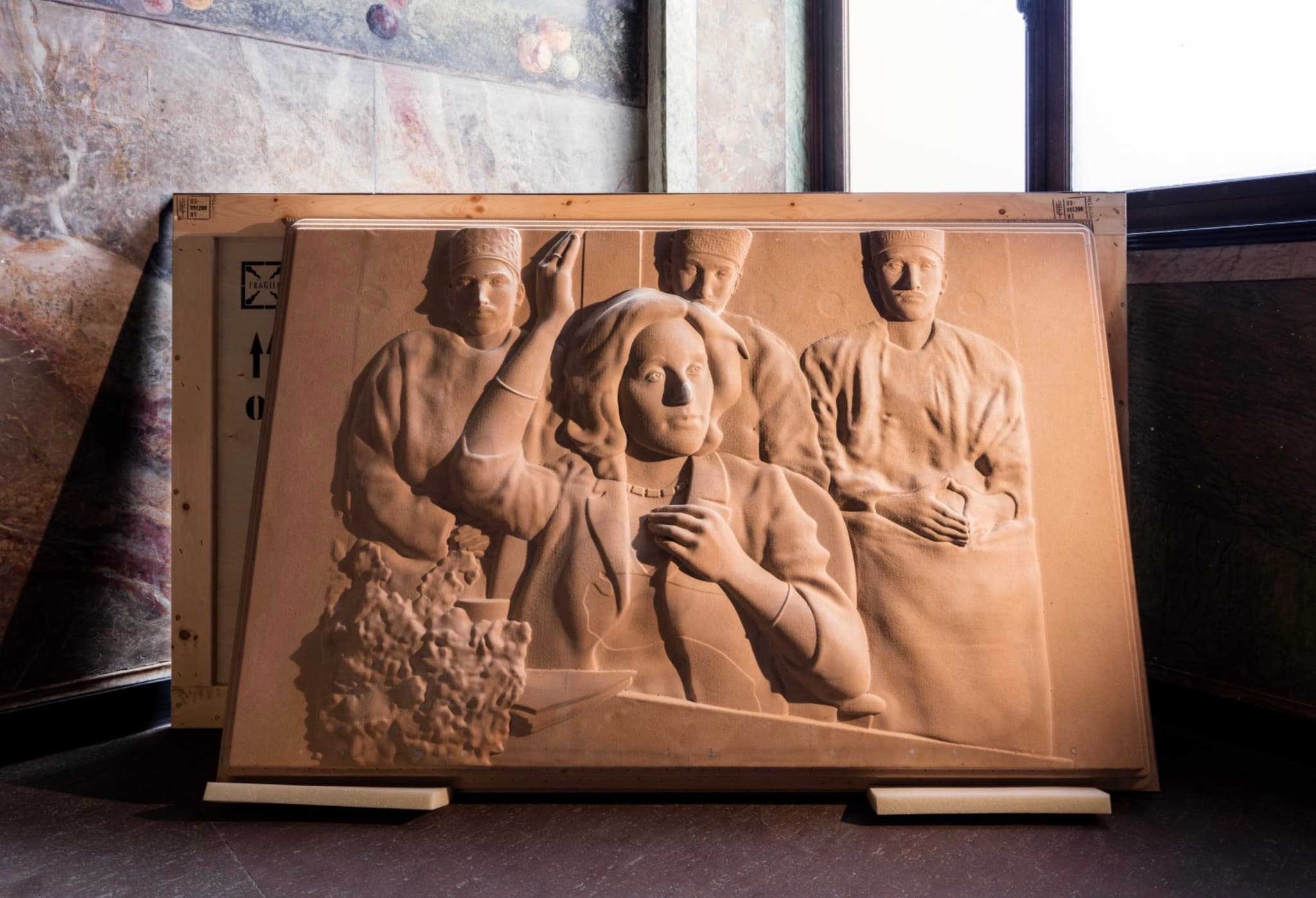Review: GCC at The James Gallery, New York
April 2018

Much of the recent work of GCC-the group of artists whose eight members hail from various Persian Gulf countries, and whose name references the acronym for a regional political and economic alliance known as the Gulf Cooperation Council-has focused on the growing popularity in the area, among both governments and the wider populace, of the "positive energy" movement. Their 2016 solo at New York's Mitchell-Innes & Nash included five bas-reliefs, in a maroon, velvet- flocked thermoformed styrene, based on 3-D renderings of stills derived from YouTube and other online sources of various regional proponents of this and other related New Age spiritual practices.
For their show at the James Gallery-a reprise of their contribution to last year's Art Basel Parcours program, where the works were pre- sented off-site in galleries and niches at the city's Natural History Museum-they showed six such reliefs, titled Mahd (Gesture I-VI), all 2017, fabricated out of sandstone-colored MDF, their uncannily artificial surface topologies softened with rubbings of baby powder. Resting against parts of their wooden shipping containers and carefully cushioned with bits of shipping foam, they resembled recently unpacked artworks or artifacts, such as ancient architectural reliefs or sarcophagus lids. Broken corners, chipped edges, and cracks snaking across some of their surfaces enhanced this suggestion of antiquity. The first one featured a man with a microphone looking directly out at us, performing the signature hand gesture of the prime minister of the United Arab Emirates, a country that boasts a bona fide minister of happiness. The English subtitle that runs along the bottom edge asks, WHAT IS THE SECRET BEHIND IT? Adding an extended thumb to the common sign for peace and victory, the cryptic gesture supplements, according to its creator, the conventional meaning of triumph with a profound expression of love. In another, a healer leads a seated group of people, their eyes closed and heads leaning back, in what appears to be a guided meditation. Two others focus in on the practitioner's hands. In one, they cover a face in a gesture that reads as both soothing and smothering. In another, the left hand lies laterally across the front of the open-faced right palm, the healing energy almost palpable in the shallow but pregnant space between them.
Belief in the Power of Believe, an audio piece that played throughout the gallery, anachronistically interweaves short excerpts from the ancient Mesopotamian Epic of Gilgamesh with bits of transcribed audio excerpted from the videos the images are sourced from, all read aloud by a robotized female voice. Though digitized, the disembodied voice is unexpectedly calming, like that of a yoga or a meditation guide or, somewhat more sinisterly, of someone engaged in hypnosis or mind control. The voice also indexes the recent embrace by governments in the region of cutting-edge artificial intelligence (just last fall Saudi Arabia bestowed citizenship on a humanoid robot named Sophia) and other related future technologies as central both to their post-oil economic plans and to their commitment to models of smart governance. How- ever, a woman recounts her frustration over the process of securing government-subsidized housing in a snippet of testimony at the end of the audio track. A projection of positive energy finally garners a response after repeated failures. This seemingly innocent anecdote troublingly posits positivity as a viable solution to bureaucratic ineptitude and to the lack of political agency, quelling all possibilities of dissent.
What is gained by representing these images and texts in a material and literary context that conjures up Near Eastern antiquity-one that attempts to transform bits of obscure online ephemera into contempo- rary cultural artifacts? The evocation of a foundational pagan, pre- Islamic prehistory of the region raises the question of why certain types of New Age spiritualities, sanitized through pseudoscience and imported from the West, are enthusiastically promoted by govern- ments, while indigenous practices derived from pre-Islamic and Islamic mysticisms are routinely marginalized and suppressed as witchcraft. And the reference to Gilgamesh suggests a genealogical link between the King of Uruk, mythologized for his construction of magnificent cities, and the contemporary rulers of the Gulf, recasting their trium- phant nation-building endeavors-bolstered by neoliberal exercises in soft power such as the instrumentalization of discourses of positive energy and happiness, and the establishment of mega-institutions of art and culture-as myths, not histories.
-Murtaza Vali